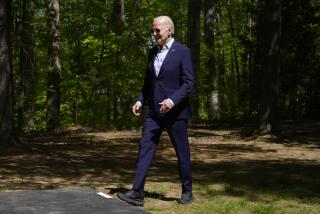Cheney to Have Aneurysm Surgery
Vice President Dick Cheney will undergo surgery next weekend to treat an aneurysm, a ballooning in an artery behind his right knee, his office announced Friday.
The vice president’s aide, Steve Schmidt, said the aneurysm was discovered during an annual checkup in July.
“It is a condition that needs to be addressed so not to become a problem over time,” Schmidt said, according to wire services.
“The procedure will be performed under local anesthetic and ... will involve a short hospital stay. The vice president will return to work shortly thereafter.”
Cheney, 64, has had four heart attacks. He underwent three hours of tests in November at the George Washington University Medical Center after suffering shortness of breath but went home when doctors found no abnormalities. It is unknown why the knee region is prone to aneurysms. One theory is that the continual bending of the knee can weaken artery walls.
Unlike aneurysms of the aorta, aneurysms behind the knee do not tend to burst. But they are dangerous because they can form blood clots that block blood flow at the knee or travel to the foot and cut off circulation there. Such clots often occur with no warning.
“If they clot off, there’s probably a 50% chance of losing your leg, whereas if you fix them electively it becomes a couple of percent,” said Dr. Steven G. Katz, professor of clinical surgery at USC’s Keck School of Medicine.
Surgery to treat the aneurysm takes two to three hours and can be done several ways. Commonly, the aneurysm is tied off and a vein from the calf or thigh is used to construct a bypass from above the site of the aneurysm to below it.
“It should be relatively low risk, as long as it’s electively repaired before a blood clot forms,” said Dr. Peter F. Lawrence, chief of vascular surgery at UCLA. Success is much lower if patients arrive at the emergency room with their foot deprived of blood, he said.
Risk factors for aneurysms behind the knee, known as popliteal aneurysms, include smoking, aging, existing heart disease and family history.
People with popliteal aneurysms are more prone to aneurysms generally. About 60% to 70% of people with a popliteal aneurysm will go on to develop an aneurysm at another site, Lawrence said. Therefore, other common places for aneurysms such as the other knee, the aorta and the femoral artery should also be checked in such patients, he said.
Associated Press reported that Cheney’s vascular exam, which uncovered the aneurysm, identified “small, dilated segments of the arteries behind both knees.”
Cheney’s heart trouble began about three decades ago. He had his first heart attack in 1978. In 1988, he underwent quadruple bypass surgery after his third heart attack. He had a fourth heart attack in November 2000, when the presidential election results were in doubt, and underwent angioplasty to open a clogged artery.
He quit smoking after the fourth heart attack, began a daily exercise program and started watching his diet. He had a pacemaker implanted in his chest in June 2001 to regulate his heartbeat.
Gerstenzang reported from Washington and Mestel from Los Angeles.
More to Read
Get the L.A. Times Politics newsletter
Deeply reported insights into legislation, politics and policy from Sacramento, Washington and beyond. In your inbox three times per week.
You may occasionally receive promotional content from the Los Angeles Times.






